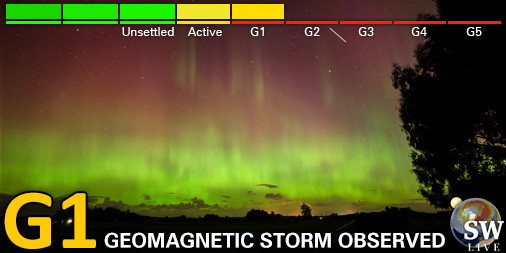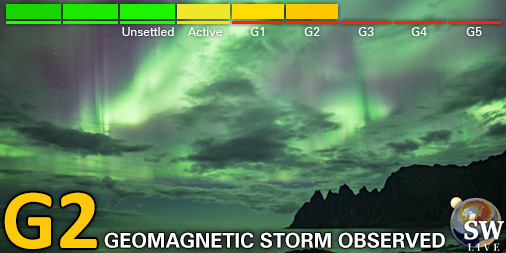Viewing archive of Tuesday, 28 April 2020
Daily bulletin on solar and geomagnetic activity from the SIDC
Issued: 2020 Apr 28 1231 UTC
SIDC Forecast
Solar flares
Quiet conditions (<50% probability of C-class flares)
Geomagnetism
Quiet (A<20 and K<4)
Solar protons
Quiet
| 10cm flux | Ap | |
|---|---|---|
| 28 Apr 2020 | 069 | 007 |
| 29 Apr 2020 | 070 | 008 |
| 30 Apr 2020 | 070 | 008 |
Bulletin
Solar X-ray flux remained below B level. Active Region (AR) 2760 (Mcintosh class: Axx; Mag. type: alpha) has decayed and been quiet over the last 24 hours. Another small bipolar region, located around S17W10 has also not shown any flaring activity. Solar flaring activity is expected to remain at very low levels.
A slow filament eruption in the northern hemisphere of the solar disk was observed around 12 UT on Apr 27. Preliminary analysis from STEREO-A COR2 data show an eruption with an initial speed of around 260 km/s and suggests there could be an Earth directed component. This may impact Earth around midday on May 02.
The greater than 10 MeV proton flux was at nominal levels over the past 24 hours and is expected to stay at nominal levels for the next 24 hours. The greater than 2 MeV electron flux was between nominal and moderate levels over the past 24 hours and is expected to be at nominal levels over the next 24 hours.
The solar wind speed near Earth oscillated around 400 km/s and the total magnetic field fluctuated around 5 nT (DSCOVR) over the past 24 hours. The Interplanetary Magnetic Field (IMF) was predominantly oriented towards the Sun (phi angle in the negative sector). Bz ranged between -6 and +5 nT. Nominal solar wind conditions are expected for Apr 28-30.
Geomagnetic conditions were quiet to unsettled (local K Dourbes and NOAA Kp recorded values between 1-3). Quiet geomagnetic conditions are expected for Apr 28-30 with isolated unsettled episodes possible.
Today's estimated international sunspot number (ISN): 023, based on 08 stations.Solar indices for 27 Apr 2020
| Wolf number Catania | /// |
| 10cm solar flux | 069 |
| AK Chambon La Forêt | 014 |
| AK Wingst | 008 |
| Estimated Ap | 007 |
| Estimated international sunspot number | 029 - Based on 28 stations |
Noticeable events summary
| Day | Begin | Max | End | Loc | Strength | OP | 10cm | Catania/NOAA | Radio burst types | |
|---|---|---|---|---|---|---|---|---|---|---|
| None | ||||||||||
Provided by the Solar Influences Data analysis Center© - SIDC - Processed by SpaceWeatherLive
All times in UTC
Current data suggests there is a moderate possibility for aurora to appear at the following high latitude regions in the near future
Gillam, MB, Yellowknife, NTCurrent data suggests there is a slight possibility for aurora to appear at the following high latitude regions in the near future
Edmonton, AB, Iqaluit, NU, Saskatoon, SKNuuk
Latest news
Latest forum messages
Support SpaceWeatherLive.com!
A lot of people come to SpaceWeatherLive to follow the Sun's activity or if there is aurora to be seen, but with more traffic comes higher server costs. Consider a donation if you enjoy SpaceWeatherLive so we can keep the website online!

Latest alerts
04:15 UTC - Geomagnetic activity
Minor G1 geomagnetic storm (Kp5) Threshold Reached: 04:05 UTC
03:15 UTC - Geomagnetic activity
Moderate G2 geomagnetic storm (Kp6) Threshold Reached: 02:59 UTC
01:00 UTC - Geomagnetic activity
Minor G1 geomagnetic storm (Kp5) Threshold Reached: 00:51 UTC
Friday, 4 April 2025
23:30 UTC - Geomagnetic activity
Minor G1 geomagnetic storm (Kp5) Threshold Reached: 23:17 UTC
21:03 UTC - Hemispheric Power Index
The OVATION model predicts the Hemispheric Power Index to reach 75GW at 21:49 UTC
Space weather facts
| Last X-flare | 2025/03/28 | X1.1 |
| Last M-flare | 2025/04/01 | M2.5 |
| Last geomagnetic storm | 2025/04/04 | Kp5+ (G1) |
| Spotless days | |
|---|---|
| Last spotless day | 2022/06/08 |
| Monthly mean Sunspot Number | |
|---|---|
| March 2025 | 134.2 -20.4 |
| April 2025 | 148 +13.8 |
| Last 30 days | 130.9 -15.2 |






